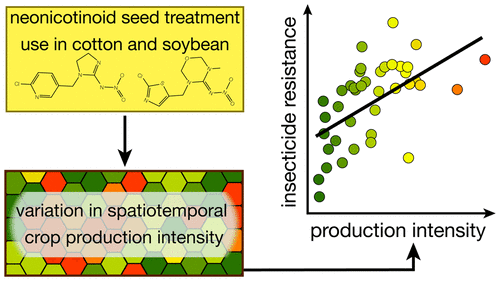Over the past 15 years, neonicotinoid seed treatments have been adopted worldwide and are used on a large proportion of U.S. field crops. Although neonicotinoids are used widely, little is known about how large-scale deployment affects pest populations over long periods. Here, we report a positive relationship between the deployment of neonicotinoid seed-dressings on multiple crops and the emergence of insecticide resistance in tobacco thrips (Frankliniella fusca), a polyphagous insect herbivore that is an important pest of seedling cotton but not soybean or maize. Using a geospatial approach, we studied the relationship between neonicotinoid resistance measured in 301 F. fusca populations to landscape-scale crop production patterns across nine states in the southeastern U.S. cotton production region, in which soybean, maize and cotton are the dominant crops. Our research linked the spatiotemporal abundance of cotton and soybean production to neonicotinoid resistance in F. fusca that is leading to a dramatic increase in insecticide use in cotton. Results demonstrate that cross-crop resistance selection has important effects on pests and, in turn, drives pesticide use and increases environmental impacts associated with their use.
Source: Huseth AS et al. Environ. Sci. Technol., 2018, 52 (4), pp 2314–2322
DOI: 10.1021/acs.est.7b06015
https://pubs.acs.org/doi/pdf/10.1021/acs.est.7b06015

- Login om te reageren
